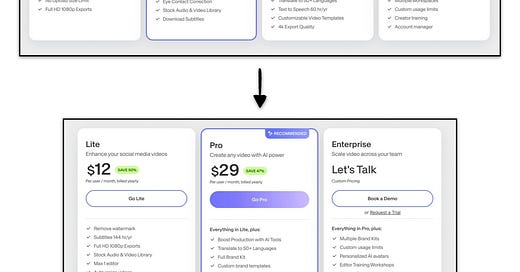Welcome back to Good Better Best.
Last week, we launched our Guide to AI Pricing, which is jam-packed with examples of AI pricing across some of the top players in SaaS. If you haven’t checked it out, give it a look here.
On to this week’s post, where we got the inside scoop on Veed’s recent pricing and packaging update.
Today’s post is brought to you by Schematic.
A truism in startups is that pricing & packaging will change. With Schematic, B2B SaaS companies can change pricing & packaging without code changes or billing refactors.
See why high growth companies, from YC startups like Zep, to scale ups like BlackCloak and Automox trust Schematic.
🚨 SaaS Product and Pricing News
Amplitude adds MTU limits to freemium and paid plans.
Statsig increases freemium limits.
Evernote increases freemium limits.
PandaDoc updates Enterprise plan positioning.
JazzHR restricts Plus plan.
Ahrefs beefed up the Standard and Advanced plans.
🔍 An Inside Look at Veed’s Pricing Change
Earlier this year, Veed, an AI-video editing tool based in London, revamped its packaging and pricing. PricingSaaS caught the update, and naturally, we wanted to learn more.
Veed’s monetization lead, Jurn van Wissen, was kind enough to tell us what motivated the changes.
What was the motivation behind reducing the annual Pro plan by $1? Was it psychological?
We tested multiple price points and annual discount percentages to see which performs best. Although we didn't A/B test 29 vs. 30, we tested other price points and found that 29 performed well. It also aligned with the prices of other plans which end in 4 or 9, charm pricing style.
We're still doing price optimization in different markets to find the ideal price points, but early results were positive enough to do these optimizations after rollout.
What are you optimizing for with this change?
Simplification of our packaging
Improving differentiation between our tiers
Better aligning our packaging with our ICP segments
Lowering churn
Adjusting to current market expectations. Upgrade drivers like subtitles have become expected in video editing software and no longer have the pricing power they used to have while we've also seen a big shift towards AI features.
How did you pick the price point for the Lite plan ($12)?
First, we aimed to define a range by doing competitor benchmarking, user interviews and some of the usual surveys like van westendorp to determine a price range for our packages. We then ran multiple experiments with different price points to find the optimal balance between conversion and ARPU in that range and $12 is what worked well for us.
How did you manage the migration of users on Basic? Did you grandfather those customers?
All changes apply only to new customers, we grandfathered all existing customers to their current plans and entitlements. Though they are able to switch to the new plans if they want to.
Was the motivation to push more folks towards enterprise plans and connect them with sales?
Just like other companies, we always try to find the right balance between self-serve plans and sales-assisted Enterprise. Every pricing professional knows the benefits of Enterprise, higher ARPU/ACV, better retention and often >100% NRR. But we also want to provide a great experience to self-serve customers. As mentioned previously, it wasn't the main focus of this rollout and we'll likely do more follow-up experimentation to find the right balance between the two.
Thanks for tuning in and see you next week!
Good Better Best reaches 5,800 SaaS leaders, operators, and investors every week. Reply to this email if you want to reach our audience.






Veed is one of my core SaaS tools 🧰 🙌
Ahrefs also introduced a new pricing plan at $29/mo. "Reports" and "AI Content Helper": https://ahrefs.com/blog/ai-content-helper/